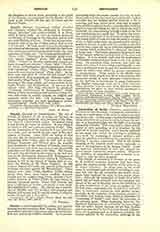

Censer, a vessel suspended by chains, and used for burning incense at solemn Mass, Vespers, Benediction, processions, and other important offices of the Church. It is now commonly called a thurible. In its present prevailing shape the censer consists of a cup, or bowl, which rests on a firm base and is provided with a hollow movable pan for holding ignited charcoal, a lid or covering, and four chains about three feet in length, three of which unite the bowl to a circular disc, while the fourth is used for raising the lid, to which one end is attached, the other passing through a hole in the disc and terminating in a small ring. To carry the censer the chains are grasped in the hand just under the disc, care being taken to keep the base elevated to a height of six or eight inches from the ground and to swing it gently to and fro in order that the current of air thus created may cause the fire to bum the fragrant gums or incense which is placed on it whenever the censer is being used. The censer played an important part in the ancient religious worship both of the Jews and Pagans. It is no wonder, then, that its employment in Christian ceremonies goes back to the very earliest times. Its primitive form, however, was quite different from what it is now, being something like a vase with a perforated cover to emit the perfumed odors. Later on chains were added for greater convenience in manipulation. These vessels in the Middle Ages were often made of gold and silver and enriched with numerous details of most elaborate ornamentation. In the archives or inventories of many Continental and English cathedrals (such as St. John Lateran, Trier, Louvain, Lincoln, and York Minster) minute descriptions are given of some ancient specimens in the possession of these churches.
PATRICK MORRISROE

